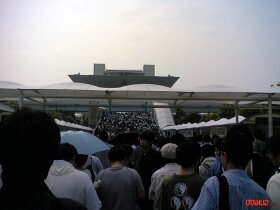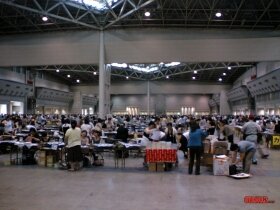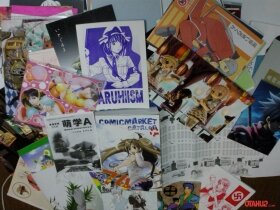 Filed under: Doujinshi Comike
Filed under: Doujinshi ComikeDoujinshi and Law
22.12.2008 by Patrick W. Galbraith
The world loves Japanese pop culture, but the Japanese themselves remain the most eager consumers of manga. Government figures show that manga represented 40 percent of all publications in 2005, and anime and live-action TV dramas are increasingly based on successful serials. But the market is saturated and sales have been slowing since the mid-90s, when digital forms of portable entertainment began to flourish. An increasingly popular outlet for manga enthusiasts is doujinshi, meaning both fan-produced manga and the “circles” that create them. They flout copyright law and rearticulate the characters they love, and their numbers are many—the largest public get-together in Japan is not a World Cup or Olympic gathering, but rather a doujinshi market called Comike.
Doujinshi began in the ’70s with original stories, but shifted to parodies of established series and characters in alternative settings and “couplings.” The genre runs the gamut from academic writing to pornography, and much of it is as sexual and violent as it is artistic. 
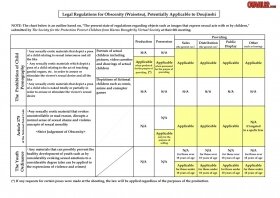 In the beginning, large coteries managed costly and labor-intensive production, but the democratization of printing in the ’80s resulted in small, even single-member circles.
In the beginning, large coteries managed costly and labor-intensive production, but the democratization of printing in the ’80s resulted in small, even single-member circles. 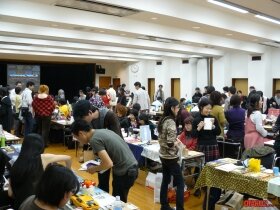
And the biggest event on the doujinshi calendar is Comike, also known as Comiket or the Comic Market, which began in 1975 and now takes over the massive Tokyo Big Sight complex in Odaiba for three days twice a year. In 2007, 550,000 people and 35,000 clubs braved two-mile-long lines to exchange 1 billion yen worth of doujinshi. The next installation is December 28 to 30, and admission is free (a 2,000-yen catalog is recommended).
In between events, the organizers of Comike run B-Maniacs and Comiket Service, which sell new and used doujinshi. As the movement becomes more widespread and easier to access, producers and consumers have increased and (to some degree) normalized doujinshi. There were 2,496 new titles published in 2003, with an average circulation of over 13,000. Starting in 1994, Toranoana, K-Books and Melon Books started selling doujinshi on consignment throughout the year. Toranoana, which has the lion's of the market, reports 14.85 billion yen in annual doujinshi sales. There were 2,496 new doujinshi titles published in 2003, each with an average circulation of 13,546.
Traditional manga publishers, licensors and distributors agree to look the other way as long as fans don’t go too far, make too much money or stop consuming official products. Daniel Pink, speechwriter to former US President Bill Clinton and a doujinshi enthusiast, pointed out in an October 2007 article for "Wired" that allowing fans to produce keeps them interested, provides free market research, and cultivates new talent. That was the case for four women who drew "Captain Tsubasa" doujinshi in the ’80s and became the international manga superstars known as Clamp.
“Japan has historically and culturally allowed copying in appreciation and to learn,” says Ichikawa Koichi, 41, an engineer who moonlights as one of the three chiefs of Comike.
However, this symbiotic balance is tenuous. In the fallout from the Miyazaki “Otaku” Murders, the “Seinen Comic” mark was adopted in 1991 to label manga that contained adult content, and all manga were required to blur out genitals. After doujinshi were found to be disobeying these rules, seven people were arrested and 67 taken into custody. A TBS announcer covering Comike proclaimed, “There are 100,000 Miyazakis here.” In March, the Chiba police put pressure on Makuhari Messe, and the event space subsequently refused to host Comike. The Harumi Tokyo International Exhibition Center welcomed the expo only after organizers agreed to screen all the content. In 1999, Nintendo sued the creator of a doujinshi featuring "Pokemon" in “unwholesome” ways, and in 2006, another creator was ordered to pay 93 million yen in back taxes and fines for unreported earnings on doujinshi.
But savvy corporations are more conciliatory. This year, Kadokawa made a landmark deal allowing “mad movies” of their "Suzumiya Haruhi" anime as long as fans marked posts on YouTube and Nico Nico Douga with Kadokawa logos. Haruhi remains their flagship series, in part because of internet support.
(Click twice, and note the Kadokawa logo below the embed link)
This resonates with academic Lawrence Lessig’s solution for copyright infringement in limited licenses for amateur creation. As philosopher and critic Tsurumi Shunsuke wrote in 1967, manga is a “border art,” a democratic medium accessible to cultural amateurs who can transgress boundaries. Perhaps doujinshi is just the next evolution. Or digression.
Comment on this article

07.11.2009 · Blog
K-Books Akihabara Renewal Ikebukuro Style
K-Books Akiba in the Radio Kaikan recently went under the re-grand opening knife and was closed from Oct. 27th and re-opened on this past...
16.08.2009 · Blog
Otaku2 in the pages of doujinshi!
Coming off of Comike 76, we have some very happy news. First, John Hathway, who provides the art for the site, released his new book and...
11.08.2009 · Reviews
Mospeada Complete Art Works Book Review
The Mospeada Complete Art Works book just hit bookstores in Japan this past Saturday August 8th. It’s the eighth volume in the...
29.07.2009 · Blog
Nakano Fujoshi Sisters at Comike
I just got word that the girls, dressed as boys again, will be performing at Comike. I guess they are going to be the only band there this...
23.05.2009 · Blog
John Hathway gets his props!
JohnHathway, the doujinshi artist behind Otaku2's imagery, has been featured by HASTAC. American academics rave about his creativity and...
23.04.2009 · Blog
Reading English manga turns heads on Japanese subways.
In the last four years I've hand many friends from overseas stay at my house when they come to visit me in Tokyo. Most buy more stuff than...
07.03.2009 · Blog
Congratulations Jamie!!!!
It's so wonderful to see friends making their dreams a reality. On my way to work the local 7/11 had the new issue of Jump Square featuring...
30.12.2008 · Features
Comiket 75 Tokyo: Itasha Photo Gallery
Roll with Haruhi! Sing with Mica Camaro! Ride with Itasha Line!






